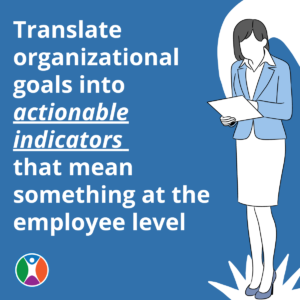We set personal goals every year, but a month passes (or mere days for some of us) and we’ve already lost sight of them. The year goes by, and we wonder what happened. It’s not just personal goals that get lost this way, though. We see the same thing happen all the time in business.
Organizations are reactive, they don’t course correct—that’s the problem
Organizations are reactive and not proactive. They look at their monthly reports the first few days of the next month and wonder what happened. What are we going to do now? Then they go into crisis mode. The key issue here is making sure that you have the right goals and indicators in place so your team can understand how they are performing. Having indicators and monitoring them regularly will tell you where you are before you hit the crisis stage.
Looking at the numbers at the end of the month is like looking at an autopsy. What’s done is done. You either hit the goal or you didn’t. There’s nothing you can do to change or influence the outcome. It’s final. That’s why being proactive about setting indicators for your goals and continuously monitoring them is so crucial. It gives you the opportunity to make adjustments that keep you on track and your goals in sight.
Determine how organizational goals translate down to indicators at the employee level
Goals are usually set at the organizational level. But when they get handed down, employees see them as someone else’s goals or measurements, not their own. There’s no ownership, no accountability because they don’t see how it applies to the work they do every day. That’s why it’s imperative that you translate your organizational goals into actionable indicators that mean something at the employee level. It’s their daily actions that determine whether your organizational goals are met.

Make your goals SMART
A goal is large and long-term. It can feel intimidating and distant. Employees think, “How do they expect us to do all that?” Instead of creating a single overarching goal, break it down into indicators to make it feel manageable. Employees will see exactly what they need to do to achieve it.
Whether you’re planning for next quarter or next year, make sure that your employees’ indicators are:
- Specific
- Measurable
- Attainable
- Realistic
- Timely
When you approach organizational goals and indicators this way, managers, supervisors and lower-level employees will be able to set individual and team goals that drive performance and ensure the goals will be met.

Engage employees and create a sense of ownership
Hitting goals requires the entire team to be proactive. Every member of your organization should have a clear understanding of what the goals are and what their role will be in achieving them. Let your team define their own indicators in the context of your organizational goals.
Give them the tools and resources they need to accomplish them, make them responsible for tracking results and hold them accountable for performance. Empowering employees instead of dictating to them will give them a sense of ownership that drives the results you want—and those you never dared to dream.
The Dorsey Group offers a Strategic Alignment Process with scorecard that enables your employees to visualize their goals and indicators, set expectations and follow trends so that there is alignment and agreement between the expected performance levels and the actual performance levels.
Does your company need extra support to create an environment where hitting a goal is more than a wish or distant possibility? Where achieving and exceeding goals is just the norm? The Dorsey Group offers comprehensive hands-on workshops designed to empower your leaders and equip your team with the tools and knowledge they need to meet your goals.
The Dorsey Group can help unleash your team’s potential and power peak performance. For more information, contact us at www.TheDorseyGroup.org or (954) 629-5774.

![[Leading People] How to Align Goals and Indicators to Set Expectations and Measure Performance on thedorseygroup.org](https://thedorseygroup.org/wp-content/uploads/2015/10/Leading-People-How-to-Align-Goals-and-Indicators-to-Set-Expectations-and-Measure-Performance-1-1080x675.jpg)